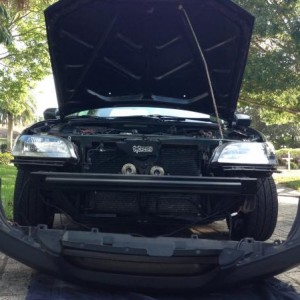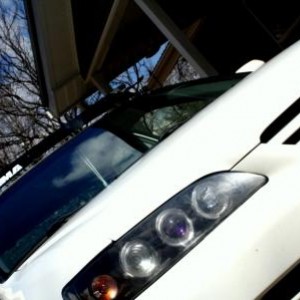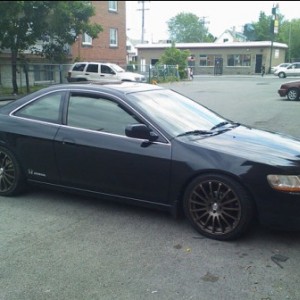Devil-V
Well-Known Member
I've posted in several threads regarding the needle behaviour - after spending/wasting lots of £££ attempting to get a custom cluster, with the help of Cluster repairs (UK) and Black Cat Custom (US), I've got a nice fully customised cluster that actually WORKS correctly with no sticking, jumpiness, no cheap tacky cheap look of custom glow gauges and no inverter wiring (the 2nd picture shows the gauges being lit with stock OEM bulbs).


Video (daytime)
Video (night-time)
NOTE: Before you think that this article is a godsend solution to customizing your cluster - take note. Fiddling with a cluster's needle is pretty delicate stuff. No-one other than yourself will be held responsible if you end up getting retardedly serious speeding tickets for doing something like 100mph for a speedo reading 70mph. Be prepared to shop around on ebay for a 2nd hand cluster and to fork out extra £££/$$$ for mileage correction, before considering any of this - driving without a cluster is a very bad (stupid?) idea. Some areas of this article may be inaccurate - as this was written purely from experimentation on a 4cyl 98-02 MT cluster.
Yes - the needles are indeed difficult to remove properly. What you need, is some cluster repair specialist who can remove the plastic needle pointer off the metal pin which it is melted/welded on.
The left picture shows that the metal pin is still inside the cluster on the tachometer, the right picture is the plastic part of the needle. This is good.


The below picture is what you don't want to pull out of the cluster. If the metal pin comes out with the needle, it can still sort of work when you put it back in, but the rise/fall response speed of the needle will be reduced significantly (and god knows what may happen after a while). This is BAD. If this happens to your fuel/temp needles - you might get away with it (this has happened on my current cluster, although the fuel/temp readings still seem to be working as of today). However, if it's your speedo/tachometer - chances are you're better off buying another cluster. Playing around with my bad cluster, it's also difficult to position the needle in the correct calibration point for some reason.

If you decide to send the cluster off (or attempt to remove the needle yourself), it's important to know where the needle calibration points are, so you know what position to insert the needles back in.
The cluster repair centre that I sent it back to, required me to insert the needles manually once I received it, and plugged into the car. Not entirely sure if some centres in the US may have calibration tools instore. I sent my cluster off without knowing what the calibration points are, so I ended up finding them out through experimenting.
What happens to the needles at the second key turn?
The tacho and speedo needles moves itself to its designated zero position, the fuel needle moves to whatever the fuel capacity is (unconfirmed, I think you actually need to turn on the ignition), and the temperature needle moves to whatever the engine temperature is at the time.
Finding the calibration points
* Take the glass off the cluster and plug it in.
* Run the car until the engine reaches operating temperature.
* Make a mental note of what the expected rev/speed/gear positions are at certain speeds. Use a long straight even road and use cruise control if available. For my CG4 (4cyl 2.0 litre), my car revs at 3250 in 5th Gear at 70mph, around 1400~1500 in 5th Gear at 30mph. Use a GPS to measure the speed in correlation to your speedo, to note the accuracy difference (my GPS reads around 1-2mph less than my speedo reading).
* Just before heading home, fill up the tank. By the time you reach home, the fuel needle should still be pointing at the full position. Do not touch the needles at any time during this.
The zero points for the tacho and speedo needles are actually BELOW the needle stopper (if you notice, the scale on the tacho between 0-1000rpm is smaller than the rest, and the 0-10mph is tiny).

* After switching off the engine (key should be in the OFF position), rotate both needles clockwise until the needles point downwards.
* Turn the key to the second position (diagnostic icons should be lit), and the needles will jump to that zero point. Make a note of where this is, as you will need to re-insert the needles pointing at that specific point.
* While the engine is still warm, the temp needle should point to the operating temperature point. The easiest method is to simply take a photo of the speedo/tacho needles pointing at the zero points below the needle stoppers, and the temp needle pointing at the engine operating temp.
Send off the cluster to get the needles removed off the metal pin and to get your custom gauge faces installed etc.
Once you get the cluster is back (assuming that the needles are off), plug in the cluster with the glass off.
* Turn the key to the second position
* Insert the tacho and speedo needles pointing towards the calibration points (insert them as straight on as possible, without too much force). Use the method illustrated by HondaLuver83
* Move the needle so that it is pointing downward, and let go. If done correctly, the needle should automatically spring back to the zero/calibration point.
* Rotate the needles anti clockwise so that they rest back on top of the needle stopper.
* Insert the fuel needle at the full position.
* Run the car for about 20 minutes until the car reaches operating temperature. During this time, turn on your GPS and check the needle accuracy.
* Switch off the engine (key in OFF position), and put the key back into the 2nd position.
* Insert the temperature needle pointing at the operating temperature point.
* Correct the speedo/rev needles if required by GENTLY removing them and repositioning them (again, using HondaLuver83's method)
* Do another road test if required.
* Switch off the engine, put the glass back on - and enjoy your new custom cluster
* If you haven't done so already, shop around on LEDAutomotive for the appropriate LEDs to match the new look.
A word of warning: Try and make sure you put the needle back onto the metal pin in the correct position on the first attempt. I accidentally took the pin out on the fuel/temperature gauge, even though they were removed from the metal pin by the repair centre (possibly from pushing the needle on too hard in the first instance). It still works, but long-term side effects are still unknown. Even today, I'm rather nervous of taking out the tacho/speedo needles for ultra fine adjustments. I have left my tacho reading about 100-150rpm under.
Hopefully you've found this post informative. The images are currently uploaded on imageshack, so they might expire after about a month - but if the feedback is positive on this article, and if someone can provide me an area where I can upload them permanently, I can reupload them.
EDIT 28/07
Oh, and if anyone is curious for some reason - this is what the real inside of a cluster looks like, without the original OEM faces (I was a little bored with my dead cluster, so I disected it for your viewing pleasure).

As you can see, if you're fortunate enough to have the needles removed properly with the metal pins intact (unlike this one), you can remove the glass panels held in by black screws without disturbing the metal pins, then start having fun planting LEDs to enhance the night time appearance. There is SO MUCH SPACE! (personally, I decided to leave mine alone ). Again, proceed at your own risk.
). Again, proceed at your own risk.


Video (daytime)
Video (night-time)
NOTE: Before you think that this article is a godsend solution to customizing your cluster - take note. Fiddling with a cluster's needle is pretty delicate stuff. No-one other than yourself will be held responsible if you end up getting retardedly serious speeding tickets for doing something like 100mph for a speedo reading 70mph. Be prepared to shop around on ebay for a 2nd hand cluster and to fork out extra £££/$$$ for mileage correction, before considering any of this - driving without a cluster is a very bad (stupid?) idea. Some areas of this article may be inaccurate - as this was written purely from experimentation on a 4cyl 98-02 MT cluster.
Yes - the needles are indeed difficult to remove properly. What you need, is some cluster repair specialist who can remove the plastic needle pointer off the metal pin which it is melted/welded on.
The left picture shows that the metal pin is still inside the cluster on the tachometer, the right picture is the plastic part of the needle. This is good.


The below picture is what you don't want to pull out of the cluster. If the metal pin comes out with the needle, it can still sort of work when you put it back in, but the rise/fall response speed of the needle will be reduced significantly (and god knows what may happen after a while). This is BAD. If this happens to your fuel/temp needles - you might get away with it (this has happened on my current cluster, although the fuel/temp readings still seem to be working as of today). However, if it's your speedo/tachometer - chances are you're better off buying another cluster. Playing around with my bad cluster, it's also difficult to position the needle in the correct calibration point for some reason.

If you decide to send the cluster off (or attempt to remove the needle yourself), it's important to know where the needle calibration points are, so you know what position to insert the needles back in.
The cluster repair centre that I sent it back to, required me to insert the needles manually once I received it, and plugged into the car. Not entirely sure if some centres in the US may have calibration tools instore. I sent my cluster off without knowing what the calibration points are, so I ended up finding them out through experimenting.
What happens to the needles at the second key turn?
The tacho and speedo needles moves itself to its designated zero position, the fuel needle moves to whatever the fuel capacity is (unconfirmed, I think you actually need to turn on the ignition), and the temperature needle moves to whatever the engine temperature is at the time.
Finding the calibration points
* Take the glass off the cluster and plug it in.
* Run the car until the engine reaches operating temperature.
* Make a mental note of what the expected rev/speed/gear positions are at certain speeds. Use a long straight even road and use cruise control if available. For my CG4 (4cyl 2.0 litre), my car revs at 3250 in 5th Gear at 70mph, around 1400~1500 in 5th Gear at 30mph. Use a GPS to measure the speed in correlation to your speedo, to note the accuracy difference (my GPS reads around 1-2mph less than my speedo reading).
* Just before heading home, fill up the tank. By the time you reach home, the fuel needle should still be pointing at the full position. Do not touch the needles at any time during this.
The zero points for the tacho and speedo needles are actually BELOW the needle stopper (if you notice, the scale on the tacho between 0-1000rpm is smaller than the rest, and the 0-10mph is tiny).

* After switching off the engine (key should be in the OFF position), rotate both needles clockwise until the needles point downwards.
* Turn the key to the second position (diagnostic icons should be lit), and the needles will jump to that zero point. Make a note of where this is, as you will need to re-insert the needles pointing at that specific point.
* While the engine is still warm, the temp needle should point to the operating temperature point. The easiest method is to simply take a photo of the speedo/tacho needles pointing at the zero points below the needle stoppers, and the temp needle pointing at the engine operating temp.
Send off the cluster to get the needles removed off the metal pin and to get your custom gauge faces installed etc.
Once you get the cluster is back (assuming that the needles are off), plug in the cluster with the glass off.
* Turn the key to the second position
* Insert the tacho and speedo needles pointing towards the calibration points (insert them as straight on as possible, without too much force). Use the method illustrated by HondaLuver83
* Move the needle so that it is pointing downward, and let go. If done correctly, the needle should automatically spring back to the zero/calibration point.
* Rotate the needles anti clockwise so that they rest back on top of the needle stopper.
* Insert the fuel needle at the full position.
* Run the car for about 20 minutes until the car reaches operating temperature. During this time, turn on your GPS and check the needle accuracy.
* Switch off the engine (key in OFF position), and put the key back into the 2nd position.
* Insert the temperature needle pointing at the operating temperature point.
* Correct the speedo/rev needles if required by GENTLY removing them and repositioning them (again, using HondaLuver83's method)
* Do another road test if required.
* Switch off the engine, put the glass back on - and enjoy your new custom cluster
* If you haven't done so already, shop around on LEDAutomotive for the appropriate LEDs to match the new look.
A word of warning: Try and make sure you put the needle back onto the metal pin in the correct position on the first attempt. I accidentally took the pin out on the fuel/temperature gauge, even though they were removed from the metal pin by the repair centre (possibly from pushing the needle on too hard in the first instance). It still works, but long-term side effects are still unknown. Even today, I'm rather nervous of taking out the tacho/speedo needles for ultra fine adjustments. I have left my tacho reading about 100-150rpm under.
Hopefully you've found this post informative. The images are currently uploaded on imageshack, so they might expire after about a month - but if the feedback is positive on this article, and if someone can provide me an area where I can upload them permanently, I can reupload them.
EDIT 28/07
Oh, and if anyone is curious for some reason - this is what the real inside of a cluster looks like, without the original OEM faces (I was a little bored with my dead cluster, so I disected it for your viewing pleasure).

As you can see, if you're fortunate enough to have the needles removed properly with the metal pins intact (unlike this one), you can remove the glass panels held in by black screws without disturbing the metal pins, then start having fun planting LEDs to enhance the night time appearance. There is SO MUCH SPACE! (personally, I decided to leave mine alone
 ). Again, proceed at your own risk.
). Again, proceed at your own risk.
Last edited:





 !!! Now my needles were way off.. i would be going 55 and my spedo said i was at 120 at 5500rpm... well this wouldnt work... So here was my fix that worked
!!! Now my needles were way off.. i would be going 55 and my spedo said i was at 120 at 5500rpm... well this wouldnt work... So here was my fix that worked




